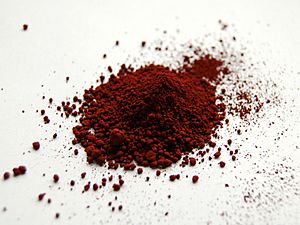Ferric facts for kids
When you hear the word ferric, it's a special way to talk about chemical compounds that contain iron. Specifically, it means the iron in that compound has a certain "charge" or "oxidation state" of +3. Think of it like iron being in a particular energy level or having a specific number of electrons it's shared or given away. These compounds are usually brown or reddish-brown, just like common rust! Ferric compounds are also known as oxidizing agents, which means they like to take electrons from other substances, often causing those substances to change or "oxidize."
Contents
What Does "Ferric" Mean?
The word "ferric" comes from the Latin word ferrum, which means iron. In chemistry, elements can exist in different forms depending on how many electrons they have gained, lost, or shared. This is called their oxidation state. For iron, the two most common oxidation states are +2 and +3.
- When iron has an oxidation state of +2, it's called ferrous.
- When iron has an oxidation state of +3, it's called ferric.
So, if you see "ferric chloride," it means you have a compound where iron is in its +3 state, combined with chlorine. If you see "ferrous sulfate," iron is in its +2 state, combined with sulfate.
Iron's Oxidation States
Iron is a metal that can easily lose electrons. When it loses two electrons, it becomes an ion with a +2 charge (Fe²⁺). This is the ferrous state. When it loses three electrons, it becomes an ion with a +3 charge (Fe³⁺). This is the ferric state.
The difference between ferrous and ferric compounds is important because they have different properties. For example, ferrous compounds are often green, while ferric compounds are typically brown, yellow, or red. This change in color is a good way to tell them apart.
Common Ferric Compounds
Many everyday substances contain ferric iron. The most well-known example is Iron(III) oxide, which is what we commonly call rust. Rust forms when iron metal reacts with oxygen in the air and water. This is why old cars or metal fences turn reddish-brown over time.
Other common ferric compounds include:
- Ferric chloride (Iron(III) chloride): This is a yellowish-brown liquid often used in water treatment to help clean dirty water. It makes tiny particles clump together so they can be filtered out.
- Ferric sulfate (Iron(III) sulfate): Used in medicines to treat anemia (when your body doesn't have enough red blood cells) and also in fertilizers for plants.
- Iron(III) hydroxide: This is a brown solid that can be found in some soils and minerals.
Uses of Ferric Compounds
Ferric compounds are very useful in many different areas:
- Water Treatment: Ferric chloride and ferric sulfate are excellent at removing impurities from drinking water and wastewater. They cause tiny particles to stick together, making them easier to remove.
- Pigments: Iron oxides, especially ferric ones, are used as pigments to give color to paints, plastics, and cosmetics. The reddish-brown color of many bricks and tiles comes from iron oxides.
- Medicine: Ferric compounds can be used as iron supplements to help people with iron deficiency.
- Agriculture: They are also used in fertilizers to provide essential iron to plants, helping them grow strong and healthy.
- Electronics: Some ferric compounds are used in the production of magnetic materials for things like computer hard drives and audio tapes.
Understanding the difference between ferrous and ferric helps scientists and engineers use iron compounds effectively in many different ways!
Related pages


